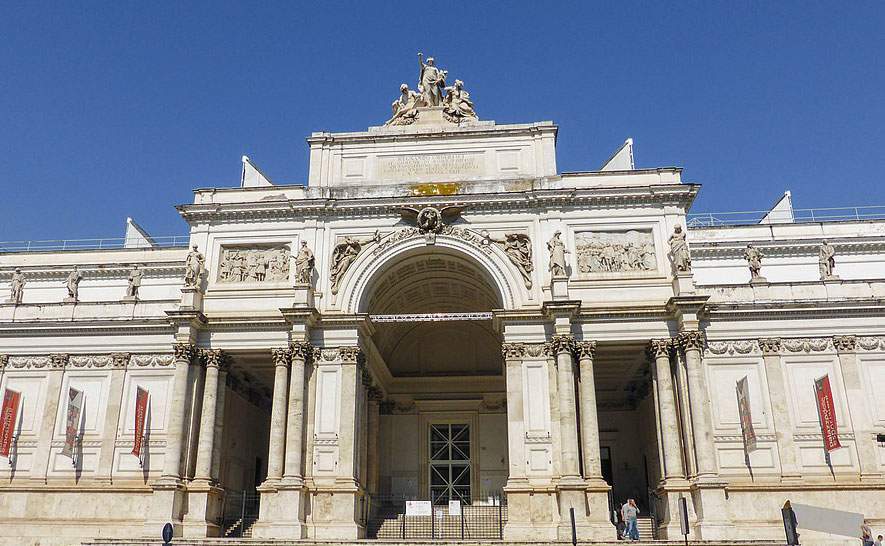The Quadrennial Art Exhibition 2020 will be Outside ... the Box. What's new in this edition
Palazzo delle Esposizioni in Rome will host the Quadriennale d’Arte 2020, curated by Sarah Cosulich and Stefano Collicelli Cagol and organized by Fondazione La Quadriennale di Roma and Azienda Speciale Palaexpo, from October 29, 2020 to January 17, 2021. The title chosen for this edition is Fuori, and pre-openings will be held on October 27 and 28. MiBACT, the main institutional partner, has confirmed through the General Directorate for Contemporary Creativity an important contribution, being the promoter of the special project Premio AccadeMibact.
“Our decision to move forward with the preparation of the exhibition by crossing the minefield of lockdown,” said Umberto Croppi, who chairs the Fondazione La Quadriennale, “was not dictated by a challenge, but by considering our mandate as a commitment to be completed. The result is that the Quadriennale will be there and will be perhaps the only contemporary art event in the international arena in the coming season.”
“The Quadriennale d’arte 2020 will be one of the most important events with contemporary art this year, a strong and vital signal that culture needs at this time,” said Margherita Guccione, Director General Creatività Contemporanea “and we are pleased to once again renew a strong synergy with Fondazione Quadriennale di Roma, a collaboration that allows for increasingly satisfactory results for the promotion of Italian artists nationally and internationally.”
The Quadriennale d’Arte 2020 intends to return a new image of Italian contemporary art at the international level, and in this sense the chosen title is significant. Fuori is in fact an invitation to go outside the box, to take an eccentric position, to adopt an oblique gaze, of mutual relationship with the other. It is a liberation from any constraint or category; an exhortation to cross the boundaries between visual arts and other disciplines to bring to life a multigenerational and multidisciplinary panorama through the works and research of the artists involved. Outside is a call to break out of the self-referential sphere in which contemporary art and its institutions often enclose themselves, and to open up to different audiences and spheres of cultural production.
It is a journey into parallel realities, obsessions, cosmic visions, erotic urges, infinite and indefinite forms of desires; a recognition of feminine, as well as feminist, approaches to research in the queer sphere and gender fluid imaginaries in the history of contemporary art, with an explicit homage to the experience of FUORI!, the first association for homosexual rights, formed in the early 1970s.
For this edition, the curators selected 43 artists in order to outline an alternative path in the reading of Italian art from the 1960s to the present. “We wanted to connect the imaginaries of younger, mid-career artists with the experimentations of pioneers who have not always found a place in the canonical narrative of Italian art,” said Sarah Cosulich. “These are artists who confront and have confronted different disciplinary fields such as dance, music, theater, cinema, fashion, architecture and design, giving rise to paths that are sometimes discontinuous but that enrich the reading of our artistic past and fortify the one produced in the present.”
Added Stefano Collicelli Cagol: “To build a visionary exhibition we were inspired by some lines of research: the expression of desires and obsessions; the exploration of the unspeakable and the immeasurable; the investigation of the tensions between art and power, represented by the metaphor of the Palace.”
The following are the artists involved: Alessandro Agudio, Micol Assaël, Irma Blank, Monica Bonvicini, Benni Bosetto, Sylvano Bussotti, Chiara Camoni, Lisetta Carmi, Guglielmo Castelli, Giuseppe Chiari, Isabella Costabile, Giulia Crispiani, Cuoghi Corsello, DAAR - Alessandro Petti - Sandi Hilal, Tomaso De Luca, Caterina De Nicola, Bruna Esposito, Simone Forti, Anna Franceschini, Giuseppe Gabellone, Francesco Gennari, Yervant Gianikian and Angela Ricci Lucchi, Diego Gualandris, Petrit Halilaj and Alvaro Urbano, Norma Jeane, Luisa Lambri, Lorenza Longhi, Diego Marcon, Raffaela Naldi Rossano, Valerio Nicolai, Alessandro Pessoli, Amedeo Polazzo, Cloti Ricciardi, Michele Rizzo, Cinzia Ruggeri, Salvo, Lydia Silvestri, Romeo Castellucci - Socìetas, Davide Stucchi, TOMBOYS DON’T CRY, Maurizio Vetrugno, Nanda Vigo, Zapruder.
Quadriennale 2020 was born out of a three-year period of research, meetings, exhibition visits, artist portfolio analysis and studio-visits. The Quadriennale’s past and its relationship with the city of Rome were also central. In particular, Q-Rated ’s traveling workshops for young artists and curators and the Q-International fund proved fundamental to the research.
New features include the doubling of exhibition spaces that will accommodate more works by the same artist, theinnovative layout of Palazzo delle Esposizioni, and a storytelling project on the history of the institution.
As the main collateral event, the exhibition Domani Qui Oggi curated by Ilaria Gianni and dedicated to the AccadeMibact Prize will be held. The award aims to promote young Italian artists and enhance the Academies of Fine Arts. The exhibition will present the creative works of the ten winners of this edition.
The Quadriennale 2020 budget amounts to 1.8 million euros, covered by MiBACT’s General Directorate for Contemporary Creativity and the two promoting partners. Eni and Intesa Sanpaolo accompanied the two-year preparatory period of the exhibition and confirmed their support for this edition as well.
The Young Collectors Association will purchase the work of an emerging artist in the exhibition to donate it to MAXXI - National Museum of XXI Century Arts.
For all info: quadriennalediroma.org
 |
| The Quadrennial Art Exhibition 2020 will be Outside ... the Box. What's new in this edition |
Warning: the translation into English of the original Italian article was created using automatic tools. We undertake to review all articles, but we do not guarantee the total absence of inaccuracies in the translation due to the program. You can find the original by clicking on the ITA button. If you find any mistake,please contact us.




























